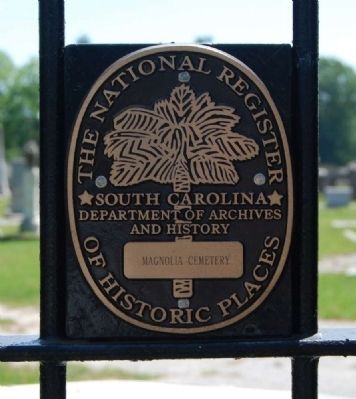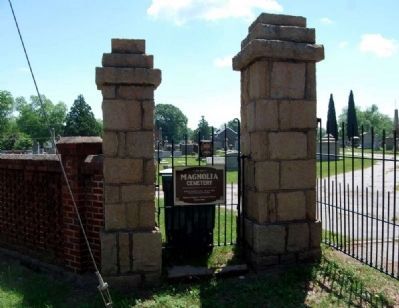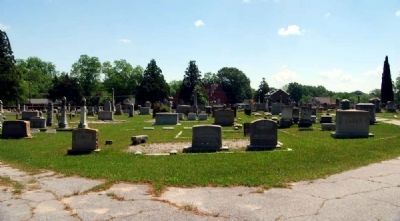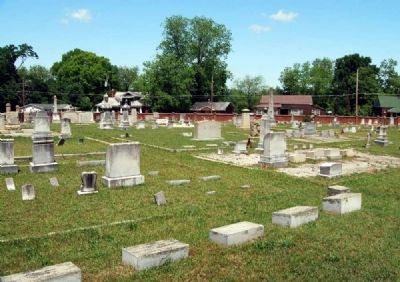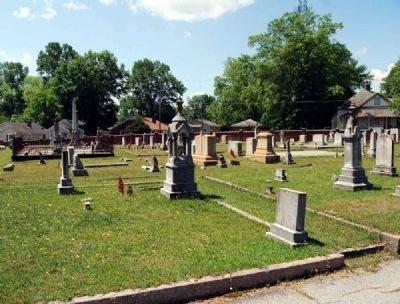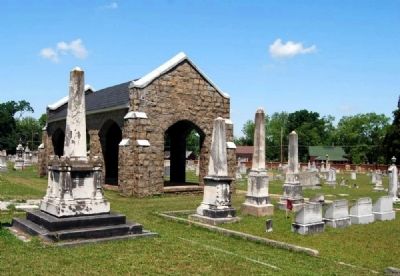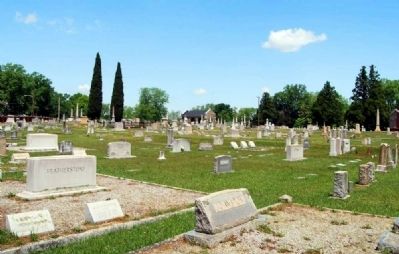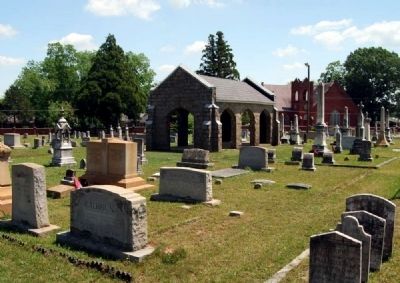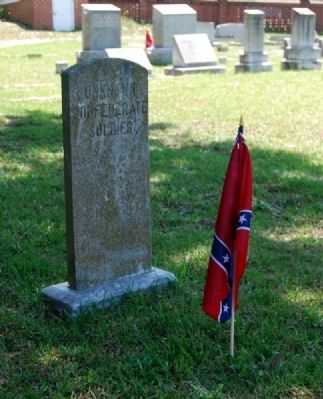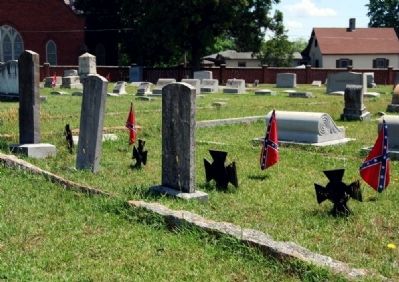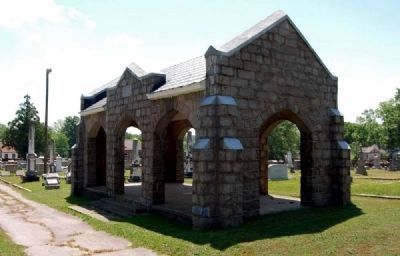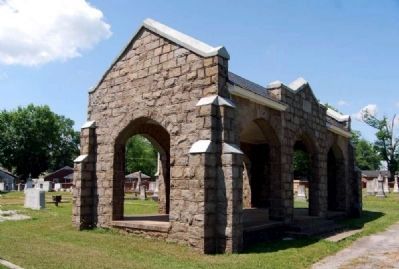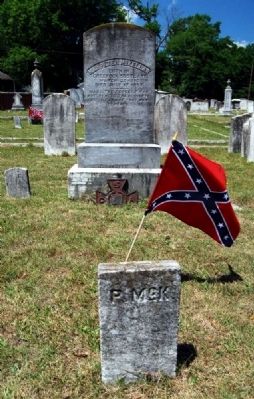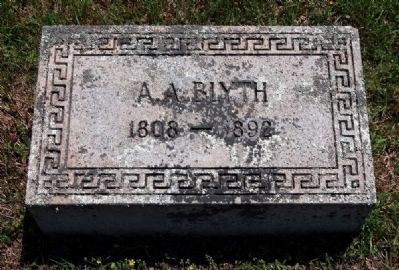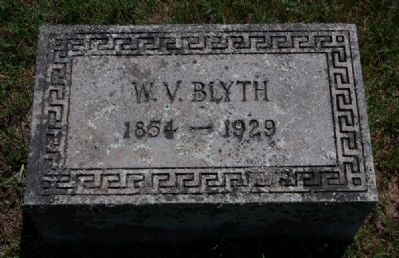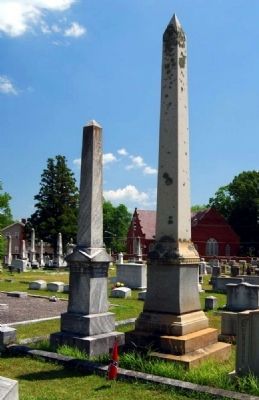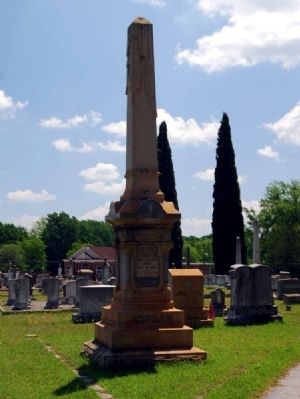Greenwood in Greenwood County, South Carolina — The American South (South Atlantic)
Magnolia Cemetery
Magnolia Cemetery
Erected 2004.
Topics. This historical marker is listed in this topic list: Cemeteries & Burial Sites.
Location. 34° 11.483′ N, 82° 9.316′ W. Marker is in Greenwood, South Carolina, in Greenwood County. Marker is at the intersection of Magnolia Avenue and Byrd Street, on the left when traveling east on Magnolia Avenue. Marker is located on the main gate, located at the intersection. Touch for map. Marker is at or near this postal address: 416 Magnolia Avenue, Greenwood SC 29646, United States of America. Touch for directions.
Other nearby markers. At least 10 other markers are within walking distance of this marker. Mount Pisgah A.M.E. Church (about 600 feet away, measured in a direct line); Marshal Ferdinand Foch (approx. 0.3 miles away); Textile Workers Monument (approx. 0.3 miles away); World War Memorial (approx. 0.3 miles away); Greenwood SC Memorial Marker (approx. 0.3 miles away); Main Street (approx. 0.3 miles away); Municipal Fountain (approx. 0.4 miles away); Old Greenwood Cemetery (approx. 0.4 miles away); In God We Trust (approx. half a mile away); To The People of Greenwood County (approx. half a mile away). Touch for a list and map of all markers in Greenwood.
Also see . . .
1. Magnolia Cemetery. Magnolia Cemetery, sometimes known as City Cemetery, was established in 1871. (Submitted on June 23, 2010, by Brian Scott of Anderson, South Carolina.)
2. D. Wyatt Aiken. David Wyatt Aiken (March 17, 1828 – April 6, 1887) was a Confederate army officer during the American Civil War and a postbellum five-term United States Congressman from South Carolina. (Submitted on June 24, 2010, by Brian Scott of Anderson, South Carolina.)
Additional commentary.
1. Magnolia Cemetery - National Register Nomination Form.(2004)
Magnolia Cemetery, sometimes known as the City Cemetery, was established in 1871 and is a mid-nineteenth to mid-twentieth century cemetery in Greenwood, South Carolina.
The cemetery, located on Magnolia Avenue in a residential neighborhood of Greenwood, sits on a four-acre tract also bounded by James Street on the northeast, Baptist Avenue on the southeast, and Byrd Street on the southwest. Within the tract, a driveway encircles the cemetery and divides it into three sections. The driveways crossing the cemetery run on the diagonal and conform to the east-west orientation of the grave markers. The graveyard is laid out in a regular grid plan and contains approximately 1,600 to 1,800 graves. Grave markers are primarily
granite or marble tablets, obelisks, square, stepped monuments capped with urns, and several Confederate grave markers, some of which still feature cast iron Maltese crosses. Most family lots are delineated with stone coping, while only a few have decorative iron fence enclosures with entry gates. Burial dates from 1872 to the present. In some cases, vandals have broken, toppled, or otherwise damaged stones. Several early graves are sunken. Burials still take place here occasionally.
This cemetery contains little discernible landscaping other than six coniferous trees along the James Street Boundary and two mature Tuscan cedars near the graveyard's center. Two notable features are a 1922 Gothic-influenced, rock-faced granite shelter near the graveyard's center and the 1941 open brick wall with concrete bevel-capped brick posts surrounding the cemetery. Both of these structures contribute to the historic and architectural significance of the property.
The granite shelter, an open arcaded pavilion, contains three pointed arches on either side and one pointed arch on either end. Featuring a decorative metal shingle-clad lateral gable roof, parapet walls with cast stone coping and double-shouldered buttresses at each corner on the sides and ends, the shelter is accessed by concrete steps through the center arch along the main driveway. A dedicatory stone is set within the pediment above the entry, while a cornerstone is visible at the northwest corner. The structure contains a concrete slab floor and a wooden interior ceiling.
The Magnolia Cemetery Association, charted in 1923, maintains the cemetery.
Significance
Magnolia Cemetery, established in 1871 with its first burial the following year, is significance as the second cemetery in Greenwood and for its association with many prominent citizens of the town from the late nineteenth century to the late twentieth century. It is also an excellent example of a late-nineteenth through mid-twentieth century cemetery reflecting typical burial customers and gravestone art during the period.
The Old Greenwood Cemetery, established ca. 1860 as the cemetery for Main Street Methodist Church and later an early city cemetery, was listed in the National Register of Historic Places in 2002.
In 1871 J.D. Creswell, a member of Rock Presbyterian Church, proposed the establishment of a cemetery in Greenwood, and several leading citizens founded the Greenwood Cemetery Company to purchase a city lot for that purpose. The first officers of the company were Dr. Ephraim R. Calhoun, president; A.M. Aiken, vice president; and Credwell A.C. Waller, secretary-treasurer.
The group purchased a lot on the corner of Byrd and Tanyard Streets for their cemetery, but it was rejected as a suitable site since some citizens believed it was too close to the courthouse square. This lot -- an agricultural field that had been cultivated in cotton and which was on what was then the outskirts of town -- was purchased from J.T. Parks. The first burial at Magnolia Cemetery, not far from the present entrance, was that of John Robert Whitlock (1854-1872), son of W.H. and S.A. Whitlock, who died of an accidental gunshot at the age of fourteen.
The cemetery was most often called "City Cemetery" until about 1920, when the name "Magnolia Cemetery" began to be associated with it; the Magnolia Cemetery Association was charted in 1923.
Among the prominent persons buried in Magnolia Cemetery are:
David Wyatt Aiken (1828-1887), Confederate colonel who commanded the 7th South Carolina Infantry until disabled by wounds in 1862, state representative 1862-66, agricultural reformer and leader of the Grange movement in South Carolina, publisher of the magazine Rural Carolinian, secretary and treasurer of the Agricultural and Mechanical Society of South Carolina 1869, member of the executive committee of the National Grange of the Patrons of Husbandry 1873-1885, and United States Congressman 1876-1886;
Andrew Alexander Blyth (1808-1892), a native of Scotland who emigrated to America by 1829 and to Greenwood County by 1846, a craftsman making cabinets, wagons, buggies, and coffins;
William V. Blyth (1854-1929), son of Andrew A. Blyth, who founded the business that became Blyth Funeral Home in 1884, the first undertaker in South Carolina to do embalming, and the first to use a motor vehicle instead of a horse-drawn carriage for a hearse;
John I. Chipley (1873-1944), who first sold bicycles and motorcycles, then was Greenwood's first auto salesman, selling Fords for many years at the "John I. Chipley Auto Exchange" and owning several successful automobile dealerships in the state and in North Carolina as well;
Thomas White Cothran (1874-1923), native of Greenwood, engineer, and architect, who served as an assistant engineer for construction with several railroads, most notable the Seaboard Air Line Railway and the Norfolk Southern Railway, and who designed many buildings in Greenwood from 1908 to 1923, including Greenwood City Hall (1908-09), buildings at the Connie Maxwell Orphanage (1909), Greenwood Episcopal Church (1911), additions to buildings at Lander College (1911 and 1920), and the James C. Self House, built in 1917-18 and listed in the National Register in 1987;
William L. Durst (1843-1902), Confederate veteran, merchant, business entrepreneur, and first president of Greenwood Cotton Mill from its founding in 1890 until his death;
John K. Durst (1851-1927), younger brother of William L. Durst, founder and first president of the Bank of Greenwood, serving from 1888 until his death, president of Greenwood Cotton Mill 1902-1906, Greenwood city councilman 1899-1905, state representative 1915-16, state senator 1917-18, and Greenwood County clerk of court 1917-18;
Samuel C. Hodges (1874-1957), pharmacist, partner in Lee and Hodges Drug Store 1899-1904, founder and owner of Hodges Drug Store 1904-1957, president of the South Carolina Pharmaceutical Association, Greenwood city councilman for ten years, and state senator 1929-1932;
David Augustus Parker Jordan (d. 1901), merchant and entrepreneur who founded Grendal Mill, Greenwood's second textile mill, in 1896, and served as its first president until his death;
Robert F. McCaslan (1836-1907), Confederate veteran as a captain of Company C, 19th South Carolina Infantry, militia colonel after the Civil War, delegate to the 1895 South Carolina Constitutional Convention, sheriff of Greenwood County 1897-1907, and intendent (or mayor) of Greenwood;
Creswell Archimedes Calhoun Waller (1838-1920), Confederate veteran as a lieutenant in Company H, 64th Georgia Infantry and captain of Company G of the same regiment, merchant, realtor, intendent (of mayor) of Greenwood 1872-75 and 1884-88, state representative 1888-89, state senator 1898-1900 and 1909-1912; and
John O. Willson (1845-1923), Confederate veteran, Methodist minister, and educator, the second president of Lander College (formerly Williamston Female College) -- succeeding his father-in-law, Samuel Lander (1833-1904), for whom the college was renamed -- from 1904 until his death.
Magnolia Cemetery's one architectural element, a Gothic revival, rock-faced granite shelter constructed in memory of Nellie Screws (1870-1917), a native of Alabama and educator who was one of three teachers who were the first to teach in the new Greenwood Graded School when it opened in 1891; she taught first grade there until her death. Though Greenwood citizens lobbied her family to allow Miss Screws to be buried in Greenwood, the Screws family insisted that she be buried in a family plot in Alabama. Citizens then organized the Nellie Screws Memorial Association and began raising money for a memorial to her in Greenwood.
The rock-faced granite shelter at the center of the cemetery was dedicated in 1922, five years after her death. A tablet bears the following inscription:
1870-1917
For twenty five years a teacher
of little children in the
Greenwood Public Schools
Magnolia Cemetery is eligible for listing in the National Register of Historic Places under Criterion A as the second cemetery in the town and for its association with prominent people of nineteenth and twentieth century Greenwood. It is also eligible under Criterion Consideration D because it derives its significance from its association with the early growth and development of Greenwood and from graves of persons important in the community.
— Submitted June 23, 2010, by Brian Scott of Anderson, South Carolina.
2.
National Register of Historic Places:
Magnolia Cemetery (added 2004 - Site - #04000590) •
Also known as City Cemetery •
Period of Significance: 1850-1874, 1875-1899, 1900-1924, 1925-1949, 1950-1974 •
— Submitted June 24, 2010, by Mike Stroud of Bluffton, South Carolina.
3. Thomas White Cothran
On the basis of his experience and proved achievements Thomas White Cothran of Greenwood is one of the leading civil and construction engineers of his native state. He comes of a prominent family of old Abbeville and Greenwood counties, and was born in a portion of Abbeville that is now Greenwood County in 1874.
His parents were Wade E. and Sarah Elizabeth (Chiles) Cothran. Both the Cothrans and the Chiles families have been long and prominently identified with South Carolina. The Chiles family came to this state from Virginia, and is numerously represented in all the South Atlantic States. Mr. Cothran's great-grandfather was Samuel Cothran, a son of Alexander Cothran, who came to South Carolina about 1815. Originally the Cothrans were north of Ireland people, and on coming to America first settled in Connecticut, and arrived in South Carolina about 1793. Samuel Cothran, the great-grandfather, married Mary Richardson.
John Cothran (1799-1860), grandfather of Thomas White, was the second son of his parents. He was a prominent planter and business man in antebellum days, owning large tracts of land and many slaves. His homestead was at Midway in Abbeville County, now a part of Greenwood County. Wade Elephare Cothran (1837-1899), was the third son of John Cothran and Elephare Rushton. The other sons of the union died without issue.
In the Millway community Wade E. Cothran spent most of his life. He was a graduate of The Citadel at Charleston in the class of 1858. He was a student of medicine in the South Carolina Medical College at Charleston when the Civil war began. He left his medical studies and became a lieutenant in Company C of the Seventh South Carolina Infantry. After a brief service he was promoted to captain of his company and later assigned to the Engineer Corps. Shortly after rejoining his command he was severely wounded at Harper's Ferry and was unable to resume duty either as a soldier or in private business until 1867. Returning to Millway he spent his life as a planter. On the formation of Greenwood County he was elected its probate judge, and was in that office until his death in 1899.
Thomas White Cothran was born and reared on the old plantation at Millway, and was a member of the first class that graduated from Clemson College in 1896. In that splendid institution he received the fundamentals of his training as an engineer. He was retained at Clemson the first year after graduating as instructor in drawing. For two years he was connected with the United States Geological Survey, being on duty in Texas, Indian Territory and Iowa. In 1900 he became an assistant engineer and later chief draftsman in the chief engineer's office of the Seaboard Air Line Railway, and was in that position for several years, though for a brief time he was with a coal mining corporation. Subsequently he was made principal assistant engineer to George A. Kent, chief engineer of the South and Western Railway (C.C.& O.), and in 1905 became resident engineer of the A.B.&A. Railway at Warm Springs, Georgia. July 1, 1906, Mr. Cothran assumed new duties as principal as assistant engineer on construction of the Norfolk & Southern Railway, between Raleigh and Newbern in North Carolina.
Since September, 1908, Mr. Cothran has been practicing his profession on his own account and with permanent home at Greenwood. He does a general engineering business and has built up an organization adequate for handling large construction contracts. This organization has put up a number of prominent buildings in Greenwood and adjoining towns and cities, among them being the Clemson College Young Men's Christian Association building.
Mr. Cothran married Miss Maud Boswell, of Portsmouth, Virginia. Their six children are Thomas W., Jr., Virginia, Mary Nelson, William Benjamin, Sarah Elizabeth and Perrin Chiles. Mr. Cothran is a member of the American Society of Civil Engineers, is a member of the American Water Works Association, a Scottish Rite Mason, also a Knight Templar and Shriner, a member of the Rotary Club and served several years as member of the South Carolina Highway Commission. (Source: History of South Carolina, Volume 5 by Yates Snowden and Harry Gardner Cutler (1920), pgs 80-81.)
— Submitted June 24, 2010, by Brian Scott of Anderson, South Carolina.
4. William L. Durst
William L. Durst, born in Edgefield county, S.C., August 31, 1843, is the son of John and Clarissa Ann (Kemp) Durst, both natives of Edgefield county, S.C. His grandfather, Peter Durst, who was born on shipboard when his parents were emigrating from Germany to America, entered the colonial army at eighteen years of age and served to the end of the Revolutionary war. His mother's grandfather, who was of English descent, came to South Carolina from Virginia, having been a soldier of the Revolution. Mr. Durst was reared in Edgefield county on a farm, being educated in one of the old style country schools. On August 16, 1861, he enlisted and was elected corporal in Company G, First South Carolina regiment, commanded by Col. Maxcy Gregg, who later became a brigadier-general and was killed at Fredericksburg. He served with Company G, First South Carolina regiment, through the whole war, surrendering at Appomattox Court House. In the battle of Games' Mill he carried one stand of colors of his regiment in the absence of the color-bearer, who was sick. He was wounded at Games' Mill, June 27, 1862, and remained in hospital at Richmond for a time, after which he returned home on a furlough, arriving on July 10, 1862. While at home he was promoted to sergeant. In February, 1863, he returned to his command in Virginia, but was yet unfit for field duty, because of his wound. Consequently he was detailed to serve as assistant bookkeeper in the South Carolina supply depot at Richmond, and was thus engaged ten months. In October, 1863, he rejoined his command at Orange Court House, and remained with it until May 5, 1864, when he was again wounded, this time in the battle of the Wilderness. On August 31, 1864, his twenty-first birthday, he rejoined his command at Petersburg, and in the battle of Jones' Farm, on October 2, 1864, he commanded Company G, having then 45 muskets. He also commanded his company at Gravelly Run on April 1, 1865. In fact, he was in command of his company most of the time from August 31, 1864, until Petersburg was evacuated. On the retreat from Petersburg and at the surrender at Appomattox he was acting adjutant of his regiment. He was struck by a ball at Gravelly Run but not disabled. At the close of the war he returned to Edgefield county and there gave his attention to cotton planting until 1888, in which year he removed to Greenwood, where he has since been engaged in cotton manufacturing and merchandising. He has been president of the Greenwood cotton mill since it was established in 1889, and is one of the proprietors of the Durst & Company co-operative store at Greenwood. He is also a director in the Greenwood Oil & Fertilizer company, and a trustee of the Greenwood graded schools. He was married, December 3, 1874, to Miss Louise DeVore, of Edgefield, of French Huguenot descent. She died April 20, 1893, and he was married the second time, on December 29, 1898, to Miss Annie L. Cothran, of Greenwood, S.C. (Source: Volume 5 of Confederate Military History: A Library of Confederate States History by Clement Anselm Evans (1899), pg 557.)
— Submitted June 24, 2010, by Brian Scott of Anderson, South Carolina.
5. David Wyatt Aiken (1828 - 1887)
David Wyatt Aiken, (father of Wyatt Aiken and cousin of William Aiken), a Representative from South Carolina; born in Winnsboro, Fairfield County, S.C., March 17, 1828; received his early education under private tutors; attended Mount Zion Institute, Winnsboro, and was graduated from South Carolina University, at Columbia, in 1849; taught school two years; engaged in agricultural pursuits in 1852; during the Civil War served in the Confederate Army as a private; appointed adjutant and later elected colonel of the Seventh Regiment of Volunteers; relieved from service by reason of wounds received on September 17, 1862, at Antietam; member of the State house of representatives 1864-1866; secretary and treasurer, Agricultural and Mechanical Society of South Carolina, 1869; member, executive committee, National Grange, 1873-1885, and served as chairman, 1875; delegate to the Democratic National Convention at St. Louis in 1876; elected as a Democrat to the Forty-fifth and to the four succeeding Congresses (March
4, 1877-March 3, 1887); chairman, Committee on Education (Forty-eighth and Forty-ninth Congresses); was not a candidate for renomination in 1886, being an invalid throughout his last term; died in Cokesbury, S.C., April 6, 1887; interment in Magnolia Cemetery, Greenwood, S.C. (Source: Biographical Directory of the U.S. Congress.)
— Submitted December 19, 2011, by Brian Scott of Anderson, South Carolina.
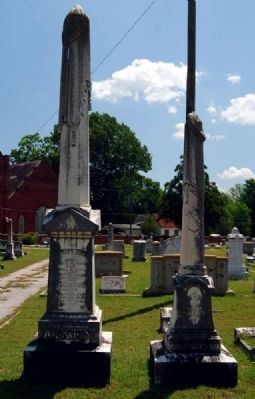
Photographed By Brian Scott, May 6, 2010
17. David Wyatt and Virginia Caroline Smith Aiken Tombstone
Left
D. Wyatt Aiken
Born
March 17, 1828
Died
April 6, 1887
----------
Devoted husband
and parent
----------
A faithful elder in
the Presbyterian
Church
----------
"He that believeth
in me, though he were
dead, yet shall
he live."
Right
Virginia Carolina
Smith
wife of
D. Wyatt Aiken
Oct. 23 1832
Jan. 16 1900
Born
March 17, 1828
Died
April 6, 1887
----------
Devoted husband
and parent
----------
A faithful elder in
the Presbyterian
Church
----------
"He that believeth
in me, though he were
dead, yet shall
he live."
Smith
wife of
D. Wyatt Aiken
Oct. 23 1832
Jan. 16 1900

Photographed By Wikipedia
18. David Wyatt Aiken
(1828–1887)
(1828–1887)
U.S. House of Representatives 1877-1887
Click for more information.
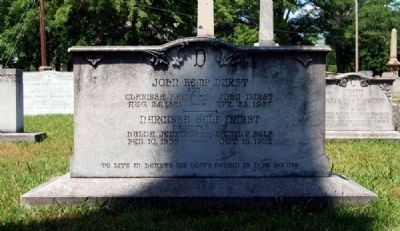
Photographed By Brian Scott, May 6, 2010
22. John Kemp and Narcissa Self Durst Tombstone
son of
Clarissa Kemp and John Durst
Aug. 24, 1851 ----- Apr. 23, 1927
>----------<
Narcissa Self Durst
daughter of
Hulda Jennings and Daniel P. Self
Feb. 10, 1855 ----- Oct. 18, 1932
To life in hearts we lave behind is now to die.
Credits. This page was last revised on December 13, 2019. It was originally submitted on June 22, 2010, by Brian Scott of Anderson, South Carolina. This page has been viewed 2,153 times since then and 44 times this year. Photos: 1, 2. submitted on June 22, 2010, by Brian Scott of Anderson, South Carolina. 3, 4, 5, 6, 7, 8, 9, 10, 11, 12, 13, 14, 15, 16, 17. submitted on June 23, 2010, by Brian Scott of Anderson, South Carolina. 18. submitted on June 24, 2010, by Brian Scott of Anderson, South Carolina. 19, 20, 21, 22, 23. submitted on June 23, 2010, by Brian Scott of Anderson, South Carolina.
